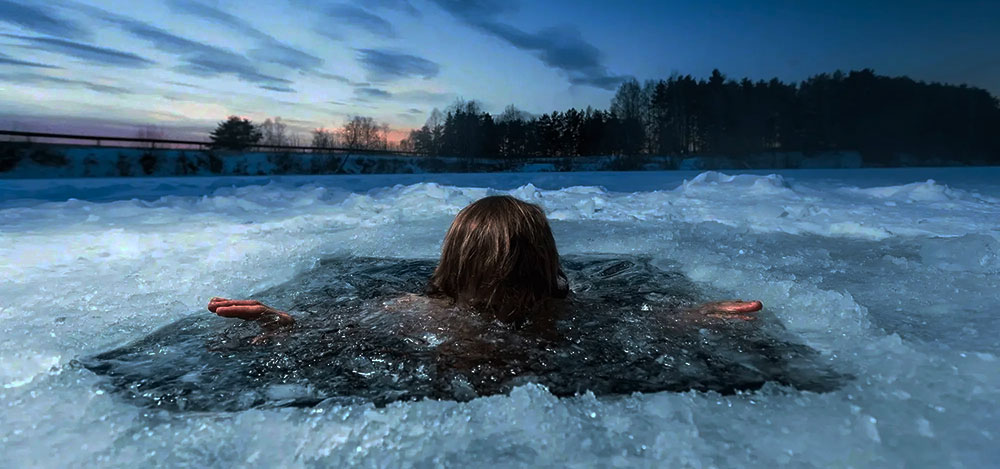
The Invigorating Benefits of Cold Plunge Therapy
In recent years, cold plunge therapy, also known as cold water immersion, has gained significant popularity among wellness enthusiasts and athletes alike. This practice involves immersing oneself in cold water, typically between 50-59°F (10-15°C), for a short duration. Just 20 seconds at 40℉ or 5–15 minutes at 50–55℉ can enhance cognition and mood. While the idea of plunging into icy water might seem daunting, the benefits it offers are compelling and backed by science. Let’s dive into the myriad ways cold plunge therapy can enhance your health and well-being.
1. Enhanced Circulation
One of the primary benefits of cold plunge therapy is its ability to improve circulation. When you immerse your body in cold water, your blood vessels constrict, a process known as vasoconstriction. This helps to redirect blood flow from the extremities to vital organs, ensuring they remain warm. Once you exit the cold water, your blood vessels dilate, promoting improved blood flow throughout the body. This process can help reduce the risk of cardiovascular diseases and improve overall heart health1.
2. Reduced Inflammation and Muscle Soreness
Cold plunge therapy is widely used by athletes to aid in recovery after intense physical activity. The cold water helps to reduce inflammation and muscle soreness by constricting blood vessels and reducing metabolic activity, which in turn decreases swelling and tissue breakdown. This can lead to faster recovery times and improved performance2. Additionally, the anti-inflammatory effects of cold water immersion can be beneficial for individuals suffering from chronic pain and inflammatory conditions3.
3. Boosted Immune Function
Regular exposure to cold water has been shown to enhance the immune system. Cold plunges stimulate the production of white blood cells, which are crucial for fighting off infections. This boost in immune function can help your body become more resilient to illnesses4. Some studies suggest that cold water immersion can increase the production of certain cytokines, which play a role in the immune response5.
4. Improved Mental Health and Mood
Cold plunge therapy can have a profound impact on mental health. The shock of cold water triggers the release of endorphins, often referred to as “feel-good” hormones. This can lead to an immediate improvement in mood and a reduction in stress levels6. Additionally, regular cold exposure has been linked to increased production of norepinephrine, a neurotransmitter that plays a role in mood regulation and can help alleviate symptoms of depression and anxiety.
5. Enhanced Sleep Quality
Cold water immersion can also improve sleep quality. The drop in body temperature induced by a cold plunge mimics the natural temperature decline that occurs before sleep, helping to promote better sleep patterns. Improved sleep quality can have a cascading effect on overall health, including better cognitive function, mood regulation, and physical recovery.
6. Increased Metabolism and Weight Management
Cold plunge therapy can aid in weight management by increasing metabolism. When exposed to cold temperatures, the body works harder to maintain its core temperature, which can lead to an increase in calorie burning. This process, known as thermogenesis, involves the activation of brown adipose tissue (brown fat), which burns calories to generate heat. While cold plunges should not replace a healthy diet and regular exercise, they can complement weight loss efforts.
7. Enhanced Resilience and Stress Management
Regular exposure to cold water can help build resilience and improve stress management. The initial shock of cold water immersion activates the body’s stress response, leading to the release of stress hormones like cortisol. Over time, this can help the body become more efficient at handling stress, leading to improved resilience. Additionally, the practice of deliberately exposing oneself to cold can foster a sense of mental toughness and discipline.
8. Potential Therapeutic Benefits
Cold plunge therapy has been explored for its potential therapeutic benefits in treating various conditions. Some studies suggest that cold water immersion can help alleviate symptoms of anxiety, depression, and even Alzheimer’s disease. While more research is needed to fully understand these effects, the preliminary findings are promising and suggest that cold plunge therapy could be a valuable tool in managing mental health conditions.
Let’s explore the science behind this invigorating practice.
The Cold Shock Response
When you first immerse yourself in cold water, your body undergoes a series of physiological changes known as the “cold shock response.” This response includes:
- Vasoconstriction: Blood vessels constrict to preserve heat and maintain core body temperature. This process redirects blood flow from the extremities to vital organs, ensuring they remain warm1.
- Increased Heart Rate and Breathing: The sudden exposure to cold water triggers an accelerated heart rate and rapid breathing. This initial gasp for air is a natural reflex to the cold shock1.
Cold Acclimatization Response
As your body adapts to the cold, it enters a phase called the “cold acclimatization response.” During this phase:
- Brown Fat Activation: The body increases the production of brown adipose tissue (brown fat). Unlike white fat, which stores energy, brown fat burns calories to generate heat, aiding in thermogenesis and weight management1.
Brown adipose tissue (BAT), commonly known as brown fat, plays a crucial role in regulating body temperature and energy metabolism. Unlike white adipose tissue (WAT), which stores energy as fat, brown fat burns calories to generate heat, a process known as thermogenesis. Let’s delve deeper into the science behind brown adipose tissue and its metabolic functions.
What is Brown Adipose Tissue?
Brown adipose tissue is a type of fat tissue that is highly vascularized and rich in mitochondria, the energy-producing components of cells. These mitochondria contain a protein called uncoupling protein 1 (UCP1), which is essential for the thermogenic process. When activated, UCP1 allows the mitochondria to convert energy directly into heat instead of storing it as ATP (adenosine triphosphate), the energy currency of the cell1. Role in Thermogenesis - Thermogenesis is the process by which brown fat generates heat to maintain body temperature, especially in response to cold exposure. When you are exposed to cold temperatures, brown fat is activated to produce heat, helping to keep your body warm. This process is particularly important in newborns, who have a higher proportion of brown fat to protect them from hypothermia2.
- Metabolic Benefits
- Calorie Burning: Brown fat burns calories to produce heat, which can contribute to overall energy expenditure. This makes it a potential target for weight management and obesity treatment3.
- Improved Insulin Sensitivity: Activation of brown fat has been linked to improved insulin sensitivity, which can help regulate blood sugar levels and reduce the risk of type 2 diabetes4.
- Enhanced Lipid Metabolism: Brown fat helps in the breakdown of lipids (fats) in the body, which can reduce the levels of harmful fats in the bloodstream and lower the risk of cardiovascular diseases4.
- Enhanced Circulation: The alternating constriction and dilation of blood vessels improve overall circulation, which can benefit cardiovascular health2.
Benefits for Athletes
Cold plunge therapy is particularly popular among athletes for its recovery benefits:
- Reduced Inflammation and Muscle Soreness: Cold water immersion helps reduce inflammation and muscle soreness by decreasing metabolic activity and swelling. This can lead to faster recovery times and improved performance2.
- Flushing Out Metabolic Waste: The enhanced circulation helps flush out metabolic waste products from muscles, further aiding recovery2.
What’s the negative effects of cold plunge ?
While cold exposure can boost your brainpower, it might be compromising your muscle-building efforts. Like all tools, cold water immersion serves a specific purpose and may be less effective — or even counterproductive — if used at the wrong time.
Initially, cold water immersion gained popularity among athletes for its ability to improve recovery by reducing inflammation, muscle damage, and soreness. It’s very effective in this regard. When used after exercise, cold water immersion reduces delayed-onset muscle soreness (DOMS), lowers markers of muscle damage and inflammation, and accelerates fatigue recovery — allowing athletes to bounce back faster for the next training session.
But this quicker recovery could come at a cost.
Recent evidence suggests that cold water immersion immediately after resistance exercise reduces gains in muscle strength and size. A 2024 meta-analysis by Dr. Brad Schoenfeld and colleagues concluded that combining cold water immersion with resistance training leads to less hypertrophy compared to the same training performed without it. Although the effects are small, they are notable. However, due to the low quality of studies included, the authors were cautious about making broad recommendations.
Another meta-analysis from 2022 found that post-exercise cold water immersion reduced strength gains during resistance training.
So, should you avoid cold water immersion after exercise if you’re aiming for muscle gains? It seems that avoiding it right after your workout is wise, especially if long-term adaptations are your goal.
How Cold Exposure Affects Muscle Growth
Immersing yourself in cold water after exercise reduces muscle blood flow. While heat increases muscle blood flow, cold has the opposite effect. This reduction in blood flow is similar to why icing an injury was once recommended to reduce swelling, though this practice is now less common.
Cold exposure also lowers muscle protein synthesis, the process that signals muscle growth. After exercise, muscle protein synthesis naturally increases, especially with protein intake. However, cold exposure diminishes this increase, even when protein is consumed during the “anabolic window” post-exercise.
These effects are short-term, affecting protein synthesis for 1–2 hours after exercise. But do these effects last over longer periods?
Regular cold water immersion during two weeks of resistance training results in lower daily muscle protein synthesis. This likely leads to reduced muscle conditioning — less strength and hypertrophy — over time. Additionally, other anabolic pathways, including the activation of key proteins and satellite cells, are reduced after cold water immersion compared to active recovery like low-intensity cycling.
How cold and how long does cold exposure need to be? Just 10–15 minutes of cold exposure at 8–15℃ (46–59℉) is enough to have these muscle-mitigating effects based on the latest research.
So, is there a way to enjoy the cognitive benefits of cold exposure without compromising muscle gains?
Striking a Balance: Reaping the Benefits of Cold Without the Costs
This is exactly what I asked Dr. Luc van Loon, and he offered some insightful alternatives:
Cold Showers: Taking a cold shower is unlikely to have the same muscle-mitigating effects as whole-body cold water immersion but can still provide mood- and alertness-boosting benefits, albeit to a lesser degree.
Timing Matters: Avoid cold exposure during the first few hours after exercise, as this is a crucial period for anabolic signaling. Waiting 6–8 hours or more after your workout may reduce the negative effects on muscle gains. To be extra cautious, consider doing cold exposure on non-training days.
Does Cold Exposure Impact Endurance Training?
Dr. Luc van Loon suggests that cold water immersion might negatively affect endurance training adaptations similarly to strength training, as protein synthesis is crucial for both. However, the evidence is not definitive. Some studies show no negative effects of cold water immersion after endurance exercise, and some even suggest benefits like enhanced mitochondrial biogenesis and improved microvascular function.
Most research, however, indicates little to no difference in endurance training adaptations when comparing post-exercise cold water immersion to no intervention or active recovery. My interpretation is that cold exposure after endurance training is likely not as harmful as it is for strength training. To be cautious, you might consider doing your cold exposure later in the day or on non-training days.
If you’re focused on building muscle size, strength, or both, avoid cold water immersion in the immediate (1–4 hours) period after exercise. Instead, use cold exposure 6–8 hours post-exercise or on non-training days. Cold showers, on the other hand, are likely fine before or after exercise if you need a quick pick-me-up.
How to Safely Practice Cold Plunge Therapy
While the benefits of cold plunge therapy are numerous, it’s important to approach this practice with caution, especially if you have underlying health conditions. Here are some guidelines to ensure a safe and effective cold plunge experience:
- Consult with a Healthcare Professional: Before starting cold plunge therapy, it’s advisable to consult with a healthcare provider, particularly if you have cardiovascular issues, Raynaud’s disease, or other medical conditions.
- Start Slowly: Begin with shorter durations and gradually increase the time as your body adapts to the cold. Starting with a cold shower can be a good way to acclimate your body.
- Monitor Your Body’s Response: Pay attention to how your body responds to the cold. If you experience any adverse effects, such as dizziness, numbness, or excessive shivering, exit the water immediately.
- Stay Hydrated: Ensure you are well-hydrated before and after your cold plunge session to support your body’s recovery process.
- Warm Up Gradually: After exiting the cold water, warm up gradually with a warm shower or by wrapping yourself in a warm towel. Avoid sudden exposure to extreme heat, such as a hot bath or sauna, immediately after a cold plunge.
Conclusion
Cold plunge therapy offers a wide range of benefits, from improved circulation and reduced inflammation to enhanced mental health and better sleep quality. By incorporating this practice into your wellness routine, you can experience the invigorating effects of cold water immersion and support your overall health and well-being. As with any wellness practice, it’s important to listen to your body and approach cold plunge therapy with caution, ensuring a safe and enjoyable experience.




